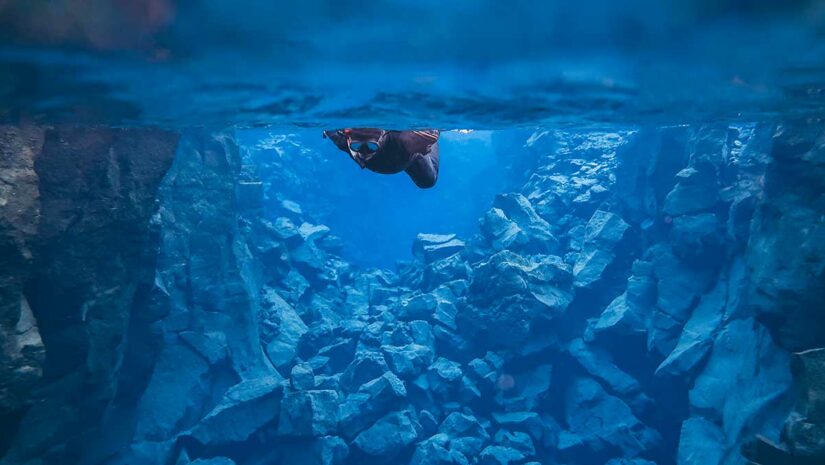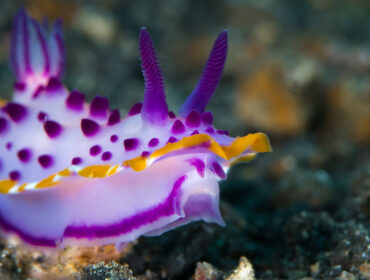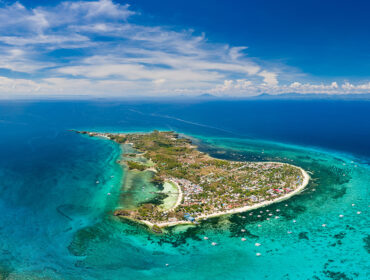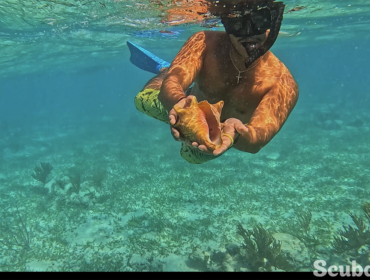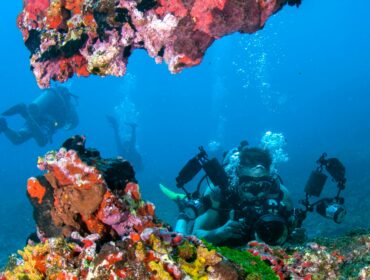The perfect combination of seismic events and melting glacial water has created one of the world’s greatest dive locations. It’s a dream destination for any cold water diver and a life-defining event for underwater enthusiasts. The Silfra Fissure is a dive site created when the earth’s crust split. We will run through everything you need to know from how to get there, what essentials to pack, and helpful tips whether you are snorkeling or scuba diving.
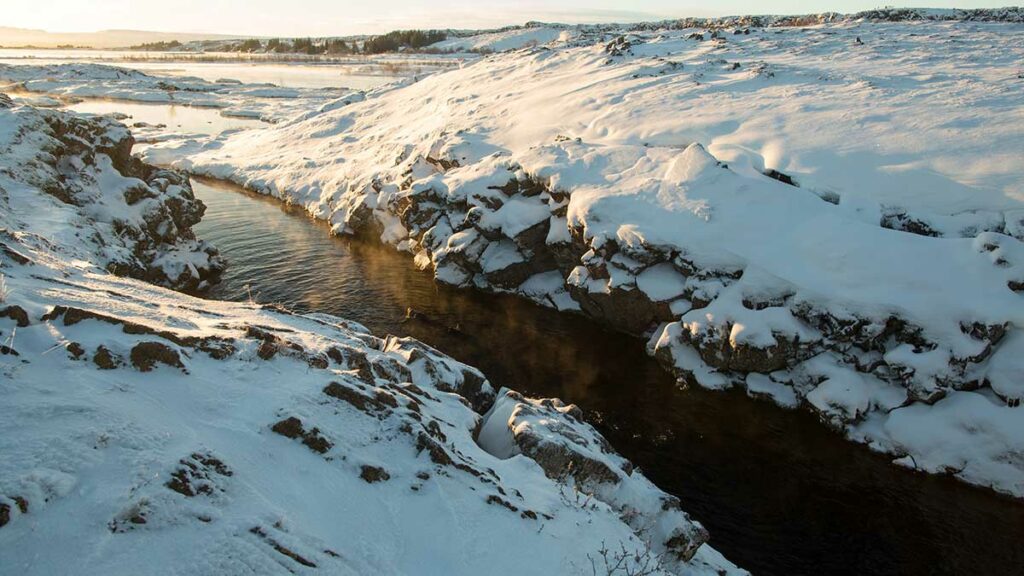
What is the Silfra Fissure?
The Silfra Fissure is a dive site located in the Thingvellir National Park in Iceland. A fissure is a large crack in the earth’s crust, and this particular fissure was caused by an earthquake over 200 years ago. Melted glacier water filled up Silfra Fissure, creating one of the world’s most unique dive locations. Water temperature is just above freezing and divers can descend as far as 63 meters or 207 feet.
The dive sites sit between two tectonic plates, those of North America and Eurasia. While it is not possible to directly touch each plate, there are points within the dive site where the rumble on either side is close enough that a diver can touch both sides with outreached arms. It is an ideal photo opportunity, creating a bridge between America and Europe.
The filtered water filling Silfra Fissure comes from Iceland’s second largest glacier, Langjökull. The clarity of this water is outstanding, allowing divers to see more than 100 meters (330 feet) ahead with beautiful tones of blue and green. The stunning natural scenery, as well as the geographical wonder of this location, makes it a common bucket list dive with several spots to explore whether you’re diving or snorkeling.
How to get to Silfra
Keflavik International Airport is the main airport into Iceland and is located outside of the capital city of Reykjavík. You can then drive 50 minutes to Silfra Fissure. It is also possible to travel with a tour operator to Silfra Fissure, who will take care of all the transport.
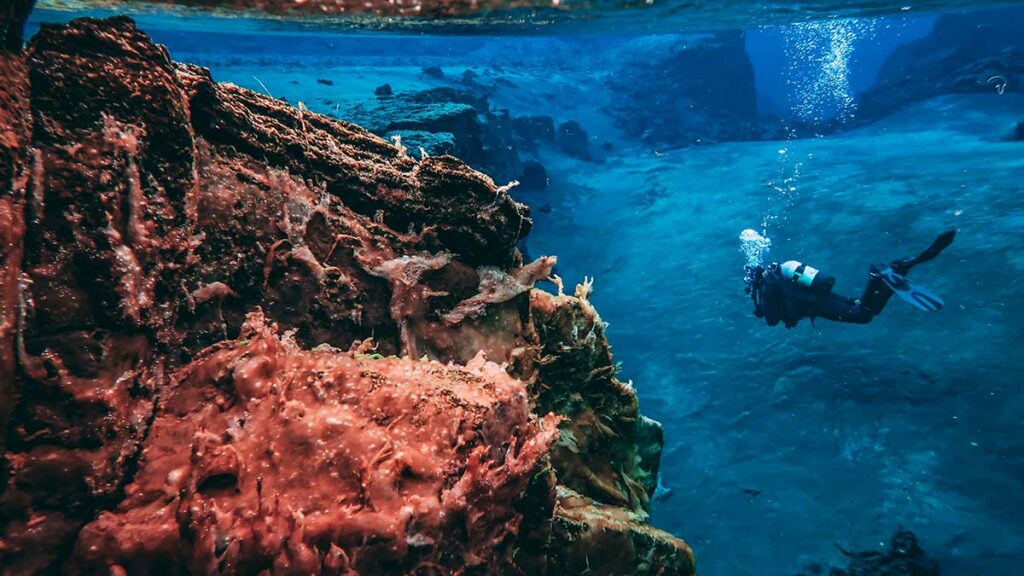
Diving in Silfra: What you need to know
The water is cold! Adjusting to cold water can be challenging if you have only done warm dives before. It is good to get some practice dives in more mild dive sites so you are fully prepared to take in all that Silfra has to offer without reacting to cold.
There is a minimum age for diving at Silfra — 17 years old — which means young divers will have to sit this one out but it is an excellent bucket list dive for adults.
While the Silfra Fissure has plenty of caves and tunnels in its hidden depths, they are off-limit to divers for safety reasons. Tectonic plates are constantly moving, so the stability of caves and overhangs is unpredictable. Just the sight of Silfra Fissure is thrilling enough — the mysterious cave system will have to remain a secret.
Even though it is a world-renowned dive site, the Silfra Fissure is not overrun with divers, in part helped by the dive requirements. This means it is possible to enjoy a peaceful dive without tons of other divers. All divers and snorkelers must prove their ability to swim with confidence in cold water, so novice explorers should not disrupt your visit.

Snorkeling in Silfra: What you need to know
It is not possible to snorkel on your own in Silfra, so you will need to be part of a guided tour who knows the fissure. Tour operators will provide all the equipment, including masks. You cannot wear glasses with scuba masks so if you have bad eyesight it might be worth getting a prescription mask.
It is best to book your scuba trip well in advance as the national park limites the amount of visitors per day. If you will only be in Iceland for a short time, it is good to plan a day in advance for snorkeling.
You can take your own camera (or phone) in a waterproof case but most tour operators are happy to take a photo of you in the water so you can fully enjoy the experience. Be sure to check with them when booking, as your safety is paramount. If you want a Silfra snap, make sure you know when and where to pose for the camera.
Silfra Fissure Diving Locations
Within Silfra, there are three main dive sites, each with their own unique features. Silfra Hall is the starting point for a large cave system with swim throughs. Unfortunately, due to depth restrictions, these are not accessible, but it is still a beautiful site.
Silfra Cathedral is the next site divers will pass through and leaves many divers awestruck. At this point, you will be able to see with great clarity over 100 meters or 330 feet to the end of the site. Dramatic fallen lava rocks make up the walls of the cathedral with a depth of 20 meters (or 65 feet) at this point in the fissure.
Finally, you will reach Silfra Lagoon, which features swaying “trolls hair” and incredibly clear water allowing divers the furthest view in Silfra. You’ll see tones of blue and green color as you make your way to the exit.
Silfra also has a tunnel affectionately named “the toilet”, which divers would enter head-first to Silfra cave. Divers can no longer access this area due to instability in the tunnel, but it is one of the first points divers will pass when entering Silfra Fissure.
Marine life in Silfra
The Silfra Fissure sits at the northern tip of Lake Thingvellir, so most marine life in Silfra is flora or microscopic creatures. On occasion, fish from the lake may enter the fissure, including stickleback and brown trout. During mating season, the Arctic Char live in the fissure.
Dwarf Char live all year round in the depths of the Silfra Fissure. They can reach up to around 8cm (3in) in size but are rare to see as they stay hidden in the darker depths of the lake or behind rocks. Silfra also has its own special amphipod, only found in Lake Thingvellir — the Crymostygius Thingvallensis.
Silfra is not a dive site for sea life enthusiasts but if you are lucky, you may spot fish darting through the water. The sheer visual of broken tectonic plates more than makes up for missing marine mammals.
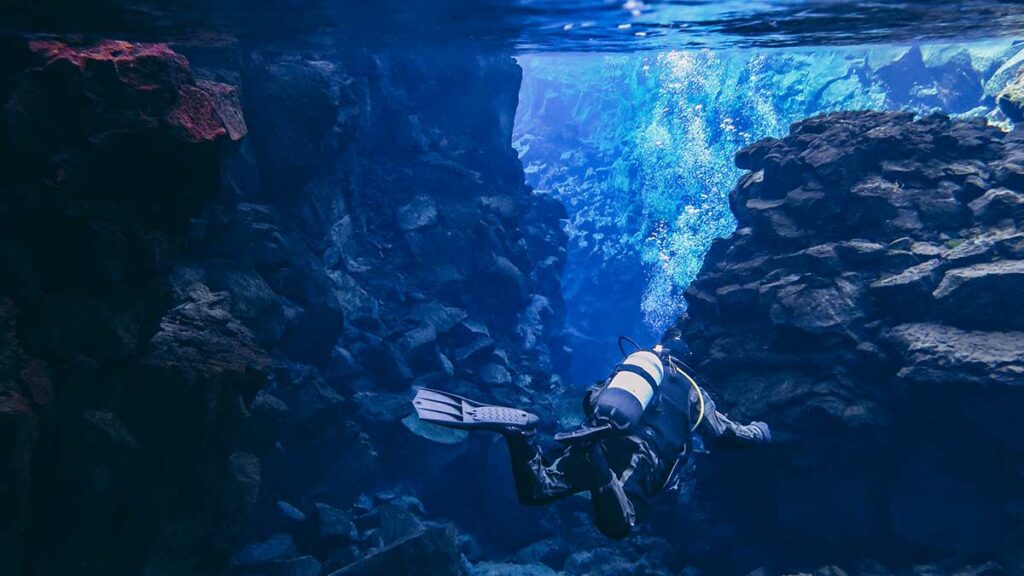
Rules for Diving the Silfra Fissure
In order to dive at Silfra Fissure, there are some rules in place to keep divers safe:
You must have an open water certification from an internationally recognized organization.
You also must have an internationally recognized drysuit certification or have logged 10 drysuit dives in the past two years. Finally, you will want to be completely comfortable diving in a dry suit and feel confident managing your buoyancy.
A medical certificate proving your health will be required depending on what conditions you have.
If you are planning to dive without a tour or local guide, you will need a diving permit from Thingvellir National Park. You can obtain this via their website or at the visitor center when you arrive.
Once you are in the water, you will need to follow the rules of the dive site. These include never diving alone, not entering caves, and not descending to a depth greater than 18 meters. The advantage of using a dive tour operator is they will keep an eye on you so you can focus on enjoying the dive. If diving independently, you and your buddy must be vigilant in following these rules.
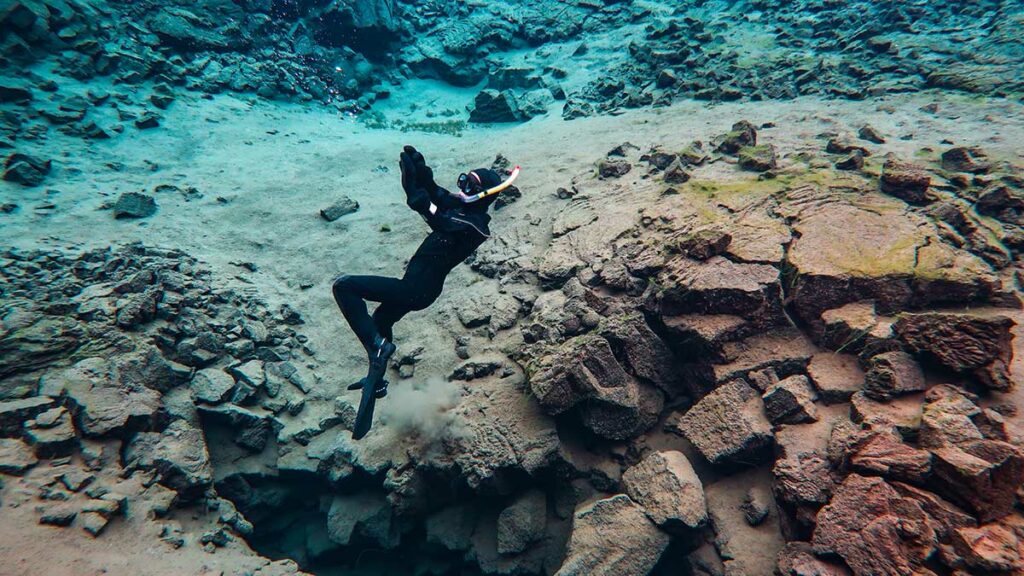
Best gear for diving at Silfra: What you need to pack
When diving at Silfra, you need to prepare for the cold. This is your number one priority. Given the importance of staying dry and warm, all snorkel or dive operators will provide most of the specialist equipment you need. Of course, if you are an experienced cold water diver and already have specialist equipment, you are welcome to use it. If you are diving with a dive school and want to bring your own supplies, it is important to let them know ahead of time to ensure they meet the correct specification for diving Silfra Fissure.
Whether you are bringing your own gear or renting on-site, here is what you will need with you to enter the icy waters of Silfra Fissure:
Drysuit
A drysuit is an essential piece of kit when diving in cold conditions. Drysuits keep you warm by capturing air in the suit, which is a great heat conductor. They keep your body enclosed in its own warm protectant while you descend into near freezing water.
Thermals & Warm Socks
Just as your drysuit will keep you dry, you can wear additional heat-preserving undergarments such as thin thermal shirts, leggings, and wool socks.
Undersuit
All drysuits are different; some come with built in undersuits, others are just a waterproof shell. If the suit you are using is a shell, then you will need to put on an undersuit to keep you warm.
Cold Water Regulator
Cold water regulators are specially designed for scuba diving in cold water. They are built to prevent freezing in cold conditions due to low pressure. The design allows the regulators to absorb warmth from the water, which stops the equipment from freezing.
Hood & Gloves
Accessories such as hoods, gloves, and boots (if not built into your dry suit) are important for keeping heat in when in cold conditions. Often fabrics like neoprene are used as a second skin to keep you warm while still allowing you a good range of movement. This is especially important for the hands.
Fins
Rubber fins are best for cold water. Cold water fins also tend to have negative buoyancy to prevent floaty feet and often have an open foot with a strap to compensate for the extra thickness of a drysuit and boots.
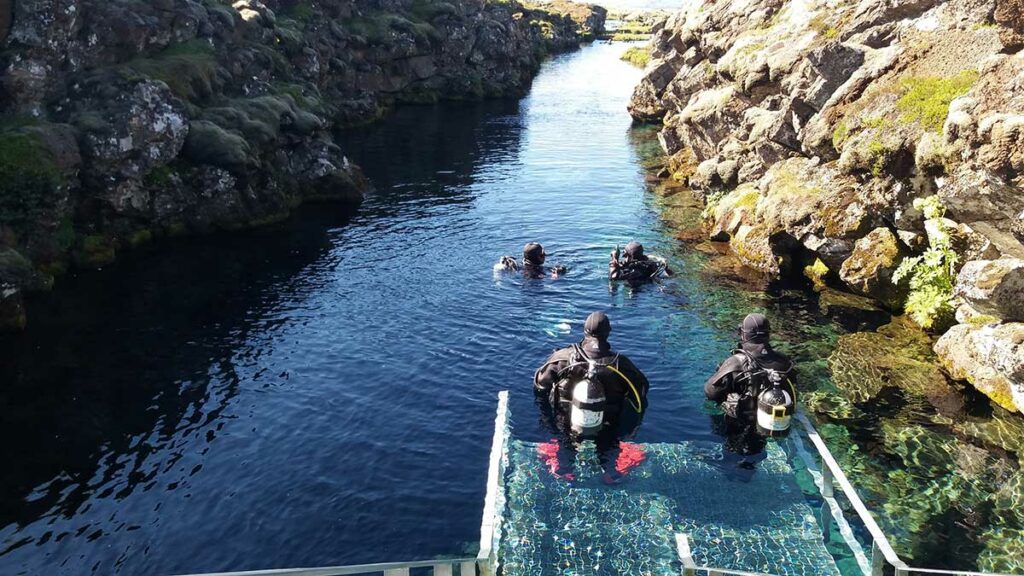
Silfra Fissure: Frequently Asked Questions
The Silfra Fissure has a maximum depth of 60 meters or 196 feet in its cave systems, but the maximum depth divers can descend to is 18 meters or 60 feet. Divers are required to have a technical diving certification and also special authorization to go deep into the cave system. Most recreational dives operate at 10 meters or 32 feet.
The water in Silfra Fissure varies from 2°C/35°F to 4°C/39°F. To survive any time submerged in these icy temperatures, you will need a drysuit and have a drysuit certification.
With visibility of over 100m (328ft), the water in Silfra is considered to be the clearest diveable water. Cool water has the highest clarity, and the water that feeds into Silfra Fissure is filtered from a melted glacier through volcanic rock. This incredible filtration combined with a mild current keeps the water clear.
Conclusion
You are now ready to descend into the stunning, clear depth of the Silfra Fissure. Be sure to have your drysuit certification and feel cold water confident to make the most out of this incredible dive site in between the earth’s crust.

